

Professor of Literature, Technology and Publishing. Every five minutes or so, someone tries to come up with a cost-per-article figure for academic publishing.

In the past, I’ve tried to do it too. But more and more I find myself wanting to resist the temptation. Not only because the data collection takes forever, but because the figures that I would produce, from my organisation, would likely not be cross-applicable to another organisation. Yet, Plan S and other organisations keep floating the idea of some kind of transparency on a per-article basis. Wiley. One topic of great interest across academia is the evolution of researcher perceptions of open access publishing and data sharing.

In September, this was the focus of the latest in Wiley’s annual surveys of the research community. The 2016 Wiley Open Science Researcher Survey* builds upon our previous surveys on open access and open data to discover trends in research. Despite geographical and subject-level differences among authors, there are underlying commonalities in open science practices. The insights reported by our respondents show a willingness to move forward with open initiatives, but confusion around the best ways to do so.
Open Access Publishing open access is on the rise, with nearly two thirds of authors indicating that they have published an article in a hybrid or full gold journal, up 8% from 2013. 58% of authors from the Asia-Pacific region reported funder requirements for open access, the most across the three regions surveyed. Article Archiving. Monitoring the transition to open access: December 2017. Factitious. Springer - The OA Effect: How does open acess affect teh usage of scholarly books. Early Career Researchers: the harbingers of change? Year one 2016. Ciber Early Career Researchers, researchers under 35 operating without tenure, are the future of research, and their attitudes and behaviour matter.
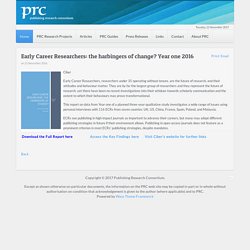
They are by far the largest group of researchers and they represent the future of research, yet there have been no recent investigations into their attidues towards scholarly communication and the extent to which their behaviours may prove transformational. This report on data from Year one of a planned three-year qualitative study investigates a wide range of issues using personal interviews with 116 ECRs from seven coutries: UK, US, China, France, Spain, Poland, and Malaysia. ECRs see publishing in high impact journals as important to advance their careers, but many may adopt different publishing strategies in future if their environment allows. Publishing in open access journals does not feature as a prominent criterion in most ECRs' publishing strategies, despite mandates.
Managing without a subscription agent: the experience of doing it yourself. Introduction Stockholm University Library (SUB) serves the needs of more than 64,000 students, 1,700 doctoral students and 5,000 staff active in the disciplines of science, humanities and social sciences.

SUB has a patron-driven acquisition (PDA) policy, where the speedy provision of requested resources is vital.1 The portfolio of individual journal subscriptions is flexible. Publishing in fraudulent journals is criminal. Predatory publishing is a curse for individual academics and universities, and a blight on the landscape of academic publishing generally.
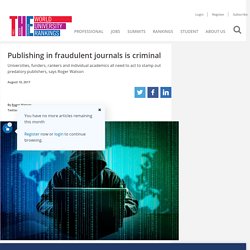
We are all familiar with those “greetings” emails asking about our health and promising to publish online any manuscript we submit in double-quick time, for a small fee. But it is not enough to just laugh at the amateur approach and then press delete. Some of these operations are outright fraudulent, vacuuming up as much money as possible over a few weeks before simply disappearing. Their websites are increasingly being made to look identical to those of existing journals, or of ones that have closed (even reactivating their old URL). I once saw one passing itself off as the nursing journal that I edit.
Many of the people behind them are also involved in other fraudulent activity, such as running non-existent academic conferences. Changing publishing ecologies report. TEF results - How do REF and TEF results compare? My first ever blog for Wonkhe was back in 2014, just after the REF results were released.
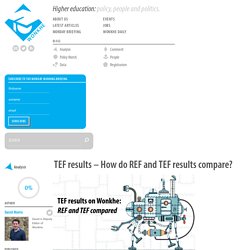
I compared those results with NSS, to see if they could give us an idea of different institutions’ strategic focuses on research and teaching. With TEF results now released, I couldn’t resist going back to this exercise to compare today’s new dataset with REF2014. Here are the results (hover over each marker to identify the university): The REF 2014 data is the GPA intensity score for universities. The role of the library in supporting open and connected research and researchers.
E-only scholarly journals: overcoming the barriers. Get out of the library - UKSG eNews. 21 Apr 2017 Donna Lanclos, University of North Carolina, Charlotte As 'the anthropologist in the stacks', I have gotten used to questions from librarians about students and faculty.

Northerncollaboration presentations. Author Services A researcher’s guide to Search Engine Optimization (SEO) Getting to grips with Search Engine Optimization, or SEO as it is commonly known, can seem a difficult task at first.
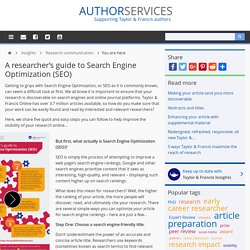
We all know it is important to ensure that your research is discoverable on search engines and online journal platforms. Taylor & Francis Online has over 3.7 million articles available, so how do you make sure that your work can be easily found and read by interested and relevant researchers? Here, we share five quick and easy steps you can follow to help improve the visibility of your research online… But first, what actually is Search Engine Optimization (SEO)?
SEO is simply the process of attempting to improve a web page’s search engine rankings. What does this mean for researchers? What is Kudos? A brief introduction. UKSG eNews. 21 Nov 2016 The National Information Standards Organization (NISO) has announced the names of five publishers now supplying metadata that conforms to phase two of the recommended practice, KBART: Knowledge Bases And Related Tools (NISO RP-9-2014).
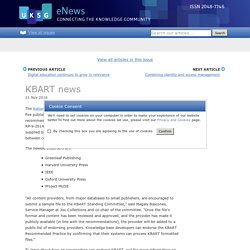
Conformity with KBART indicates that the format and content of data supplied by these publishers observe practical recommendations for timely exchange between content providers and knowledge base vendors. The newest endorsers are: Greenleaf PublishingHarvard University Press IEEEOxford University Press Project MUSE "All content providers, from major databases to small publishers, are encouraged to submit a sample file to the KBART Standing Committee," said Magaly Bascones, Service Manager at Jisc Collections and co-chair of the committee. To learn about how an organization can endorse KBART, and for more information on the initiative's Phase II activities, visit the NISO website.
LMS. Staffing. Information Literacy. Workshops & Seminars. Learn to code. Internet Archive Book Images. "A New Partner in the Process" by Leslie J. Foutch. Abstract Academic librarians have tremendous opportunity to demonstrate their worth to the institutions they serve.

One successful approach is for faculty and librarians to collaborate on a research project; however the frequency of such partnerships has not been readily documented in academic library literature. This paper shows how the addition of an academic librarian to a faculty research team led to a better understanding of how faculty projects operate, and how the process can lead the way for librarians to be seen as valuable research partners in the academic landscape. Recommended Citation. About - Project Counter. COUNTER is a non-profit organization supported by a global community of library, publisher and vendor members, who contribute to the development of the Code of Practice through working groups and outreach.
All members’ fees contribute to maintaining and developing the COUNTER Code of Practice. See the Members List for a complete list of member organizations. Become a Member. Hints & tips. 1Friendly Guides to COUNTER Reports COUNTER, via Mitchell Dunkley, a Principal Information Assistant for De Montfort University (DMU) Library & Learning Services, has provided three guides for understanding COUNTER reports:Friendly Guide to COUNTER Journal ReportsFriendly Guide to COUNTER Book ReportsFriendly Guide to COUNTER Database Reports 2Usage Scenario for Result Clicks and Record Views In order to help librarians understand Result Clicks and Record Views in the COUNTER Database Reports, Eric Howard, Information Services Librarian at Leeds Beckett University, has created and shared this Usage Scenario. 3COUNTER Quick Guide to Result Clicks and Record Views COUNTER has received a number of queries about the definitions of Result Clicks and Record Views and how to use them in evaluating database usage.
A Quick Guide can be found on the COUNTER website: 4When I download my Web of Science DB1 report, it doesn’t appear to be compliant.
JIBS website. Value for Money in Research Support: Perplexing problems, practical solutions 8th July 2015 at JISC Collections offices in Brettenham House, London. ePub3: a vision for the future? Learning Analytics and Metrics. Research and Repositories. Journals and Databases. Acquisitions. Fines. Learn to code. 7 Steps to Increase Digital Participation. Research by the Tinder Foundation shows that those households who are least likely to be digitally connected are the very same households who are also likely to be struggling on a whole range of other measures of social and economic prosperity. And as technology gets better and faster, the divide between those who are connected and those who are not grows ever wider. Put simply, digital technology is exacerbating already well-entrenched inequalities when it should be bridging them.
Free UKSG webinar: Future Casting – The Horizon Report and Beyond. Programme and slides. Session sponsored by PebblePad. LILAC 2014. 60-Second Adventures in Thought. Materials. A Quick Guide to the Flipped Classroom.
Abingdon & Witney College. Hecommissionreport-toogoodtofail. E safety. Taylor & Francis Libsite - Use of social media by the library. Skip to navigation Social media has the potential to facilitate much closer relationships between libraries and their patrons, wherever they are based, and however they choose to access library services and resources. This white paper has been researched and compiled by Taylor & Francis to provide an overview of current practices relating to the use by libraries of social media, from a world-wide perspective, against which individual institutions can benchmark their own activities and be inspired to try new approaches.
Read the Taylor & Francis white paper on social media use in libraries Learn more about the key findings from the white paper: Watch the presentations from the UK launch event | Read the transcript Visualisation of key findings from the white paper on social media use in the library:
Fake it ’til you become it: Amy Cuddy’s power poses… visualized. College. Library Skills. Copyright. Digital Learning + Apps. Work skills. Blended learning and Flipped Classroom.